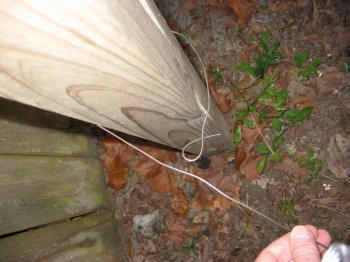
*Working with Wire*
As you can tell by my moniker I have an affinity for rope and cordage. Frankly I get a bit irritated when I come across something that has been spontaneously engineered with wire. But hey, wire does have its uses. Many, in fact. And you canít tie up a dangling muffler with string anymore than you can use plastic ties to hang a cook pot over an open fire.
They say the west was won by Colt but it was certainly changed forever by wire. Specifically, the barbed wire fence. In Australia the outback was built with wood and wire. During Australiaís colonization wire was plentiful and the locals used it for everything from building fences to barns, shanties and farm implements.
For the preparedness minded and the homesteader wire can be a very useful commodity to have on hand. Itís cheap and easily obtained from just about any store. Expect to pay a penny per foot or less. In this article Iíll briefly describe a few tricks of the trade to assist you in the proper use of wire. My sources are both personal and researched. I highly recommend a set of books titled, "Bushcraft" by Ron Edwards. They are published in Australia but often available in the states. Just do a web search. So here goesÖ
The first trick is the Cobb & Company Hitch. Itís the preferred way of connecting wire to a fence post. Itís quick, secure and simple. As a side note, some use to drill holes in fence post and simply run the wire through the hole. It was later found that the drilled hole allowed moisture in the post and it rotted quickly. The hitch is all you need. Use it to erect camp shelters, cooking tripods, etc. Itís sort of like a useful knot. Once you get used to tying it, itís the way youíll connect wire to just about anything.

Start by running the wire around the post and making a small loop that curls back "under" itself.
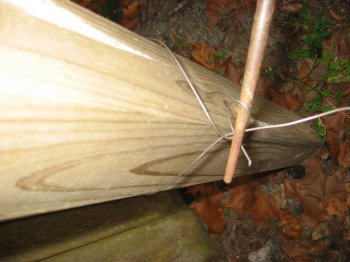
Place a rod, plier handle, stick, file tip or whatever is handy through the loop and rotate counter clockwise.
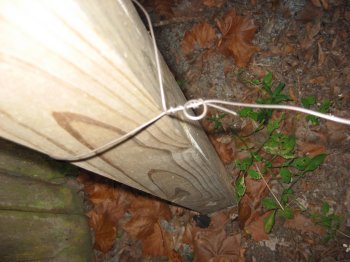
The wire will close in on itself and lock in tight.
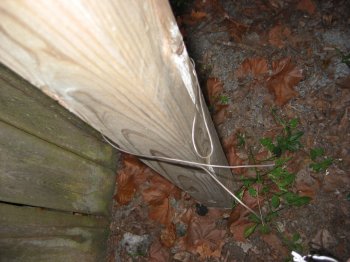
You can tie a "Double Cobb & Company Hitch" by doubling the wire around the post.
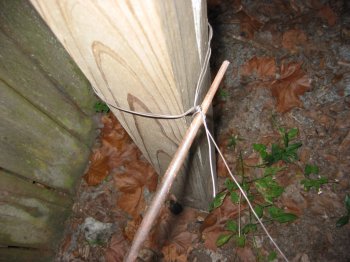
Rotate the rod counterclockwise and sheís tight.
For connecting two pieces of running together there are several methods that work just fine. The wire companies in Australia did quiet a bit of research and found that the "figure of eight" was the preferred way for strength and simplicity. The end result is a wire connection very close to the original strength of the wire.
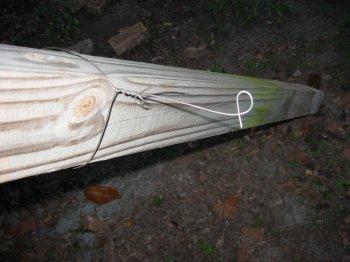
Start the figure of eight wire knot by making a small loop in the wire. Make sure the working end is over the standing end.
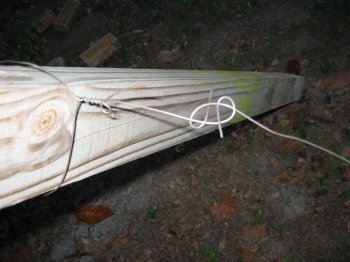
Run the end of the connecting wire through the loop you just made. Bring it around under the wire (toward you), over and then through its own loop.
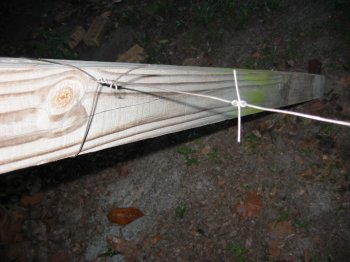
Pulled tight, it looks like this. (Notice the Cobb & Company hitch to the left)
I donít think I need to go into details about pliers and wire cutters. As with any tool, I try to buy once and buy right. I like Klein tools found in the electrician section of the big hardware stores. A good set of linemanís pliers is the most versatile and just about all you could ever want. Here are a few of my wire working tools that I like to have on hand;
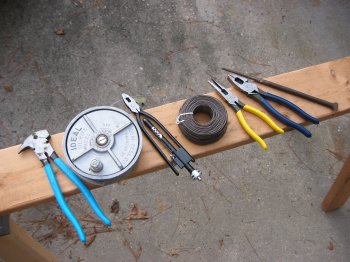
A good hardware store sells reels for the dispensing wire. Itís a handy device when working with rebar. If you find yourself in need of constructing temporary structures youíll find it very handy.
Just to the right of the wire reel is a set of safety wire twisters. By pulling on the silver knob on the end the whole set of pliers rotates and puts a quick and tight twist in the wire.
Like I said before, I get irritated when I come upon something that is wired together. Maybe itís because I canít just whip out my pocket knife and cut it. Hmm? So stuff wired together isnít supposed to be easy to undoÖ.
If you havenít already, stock up on wire. Try these techniques and I think youíll use them often. Enjoy.
www.alpharubicon.com
All materials at this site not otherwise credited are Copyright © 1996 - 2003 Trip Williams. All rights reserved. May be reproduced for personal use only. Use of any material contained herein is subject to stated terms or written permission.